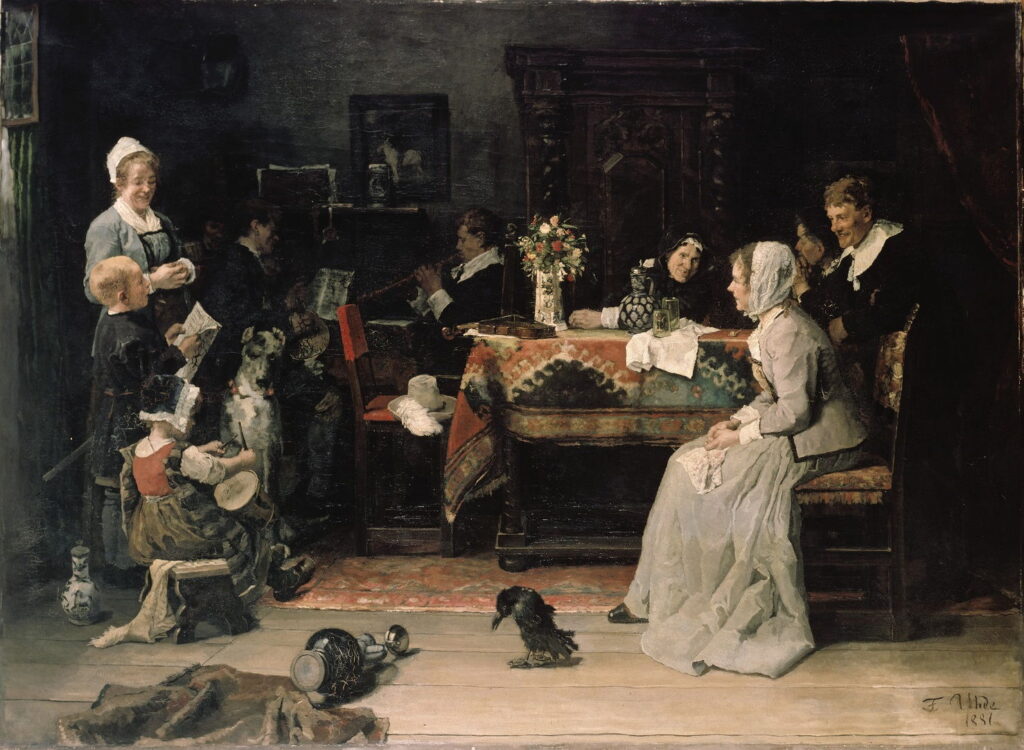Interiors by Design: Music rooms

What did we do in the evenings before the arrival of TV and radio? People read, talked to one another, played games, and made music. Many middle class homes had a piano, and many children became accomplished musicians. For this, we went into the music room. In one of the houses in which I grew up, we had a drawing-cum-music room containing a wonderful German upright piano that I practiced on daily. Here are some examples from the modest to the grand and regal.
Johannes Vermeer (1632–1675), The Concert (c 1663-66), oil on canvas, 72.5 x 64.7 cm, location not known (stolen from Isabella Stewart Gardner Museum, Boston, MA, on 18 March 1990). Wikimedia Commons.
Music features in several of Vermeer’s paintings, in The Concert (c 1663-66) more particularly than any other. Two ladies are making music, one playing a decorated harpsichord (or similar), the other singing. In the left foreground is a cello resting on its back. Tragically, on 18 March 1990 this and a dozen other works were stolen from the Isabella Stewart Gardner Museum in Boston, MA, and it remains unrecovered.
François Flameng (1856–1923), Concert at Versailles (date not known), further details not known. Wikimedia Commons.
If your home happened to be the palace at Versailles, then you could have a grander music room or two, as shown in François Flameng’s undated painting of a Concert at Versailles.
Adolph Menzel (1815–1905), Concert for Flute with Frederick the Great in Sanssouci (1850-52), oil on canvas, 142 x 205 cm, Alte Nationalgalerie, Berlin, Germany. Wikimedia Commons.
In the case of Adolph Menzel’s Concert for Flute with Frederick the Great in Sanssouci (1850-52), you could get the composer CPE Bach to accompany you on the harpsichord, and your flute teacher, Johann Joachim Quantz, to listen at the far right. This concert would have taken place in this palace near Potsdam in Germany about a century earlier, in about 1750.
Herman Frederik Carel ten Kate (1822–1891), The Music Room (1871), oil on panel, 65.3 x 98 cm, location not known. Wikimedia Commons.
The Music Room, painted by Herman Frederik Carel ten Kate in 1871 also shows a concert from the previous century. While this slightly more modest music room features a couple singing to the accompaniment of the piano, and there are musical instruments in the centre foreground, everyone else in the room is engaged in decidedly non-musical activities.
James Tissot (1836–1902), Hush! (c 1875), oil on canvas, dimensions not known, Manchester Art Gallery, Manchester, England. Wikimedia Commons.
James Tissot’s Hush! from about 1875 shows a musical performance in a private residence, no doubt attended by the cream of society. Among the honoured guests at the right are two from the Asian continent, but the distinguished host is still awaited, their chair empty, and the violinist poised to begin her command performance once they are ready.
Fritz von Uhde (1848–1911), Family Concert (1881), oil on canvas, 187 x 253 cm, Wallraf-Richartz-Museum & Fondation Corboud, Cologne, Germany. Wikimedia Commons.
Fritz von Uhde’s Family Concert from 1881 is more typical of a musical evening in a middle class household, apart from the bedraggled crow in the foreground, who seems out of place.
Hanna Pauli (1864-1940), Friends (1900-07), oil on canvas, 204 x 260 cm, Nationalmuseum, Stockholm, Sweden. Wikimedia Commons.
Although the piano in the left foreground isn’t being played, Hanna Pauli’s group portrait of Friends (1900-07) shows an interesting group gathered in her family home. Among those present are the writer Ellen Key (1849-1926), a ‘difference’ feminist and advocate of child-centred parenting and learning, who is reading to the others.
Julius Schmid (1854-1935), Schubertiade (1897), further details not known. Wikimedia Commons.
Julius Schmid’s Schubertiade returns to the chandeliers of the past. This was painted in 1897 to celebrate the Austrian composer’s centenary, and shows him performing to a packed music room in the early years of the century.
Music rooms were also features of more compact homes.
Édouard Vuillard (1868–1940), Morning Concert, Place Vintimille (1937-38), distemper on paper laid down on canvas, 85.1 x 98.7 cm, location not known. Wikimedia Commons.
Between 1908-26, Édouard Vuillard lived in a fifth floor apartment in Rue de Calais, Paris, overlooking what was then known as Place Vintimille, now Place Adolf-Max. In his Morning Concert, Place Vintimille from 1937-38, a trio of friends are playing for the artist in his apartment.
By that time, some music rooms featured cabinet radios and gramophones for family groups to listen to music performed by those not present.



